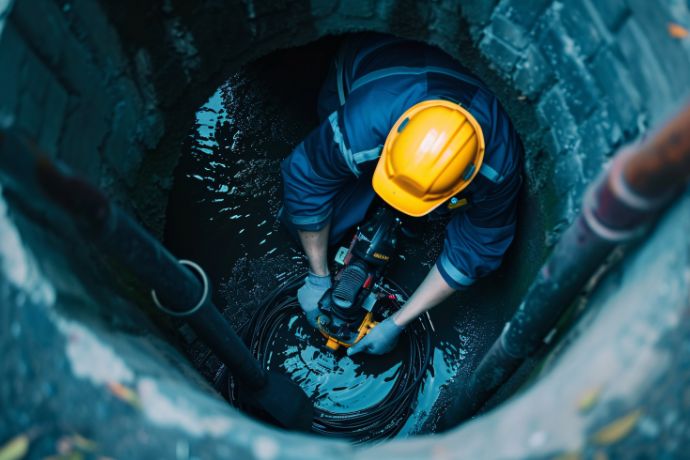Blogs
Why Should I Use a VFD Instead of a Soft Starter for Lift Station Pumping?


Decision makers in lift station pumping systems are left with a crucial decision: choosing between a Variable Frequency Drive (VFD) and a soft starter. While both devices control the operation of pumps, they do so in different ways and offer distinct advantages. This article explores those differences and recommends ways to achieve cost and energy savings.

Decision makers in lift station pumping systems are left with a crucial decision: choosing between a Variable Frequency Drive (VFD) and a soft starter. Both devices control the operation of pumps, but they do so in different ways and offer distinct advantages. It is important to assess what your operational goals are (i.e. increase pump life, decrease energy usage, prevent downtime) before making this decision to ensure you are getting the most out of your investment. This article explores why a VFD is often the superior choice for lift station pumping applications.
Understanding operational lift station goals
Before one can choose whether a VFD or soft starter would be most appropriate in their lift station control system, we recommend having a clear goal. Is the goal to…
- 1. Reduce energy consumption
- 2. Update existing, outdated controls
- 3. Increase the lifespan of your pumps
- 4. Prevent maintenance visits and associated downtime
Now that your expectations are set, you can align which control will provide the best ROI.

What is a VFD and soft starter?
Variable Frequency Drives (VFDs) are electronic devices that control the speed and torque of electric motors by varying the frequency and voltage of the power supplied to the motor. They allow for smooth acceleration and deceleration throughout the operation allowing for prolonged equipment life.
Soft Starters, on the other hand, reduce the torque during motor start-up by gradually increasing voltage to electric motors until it reaches full speed. The gradual ramp-up helps to minimize mechanical stress on components. [1]
The key differences between VFDs and soft starters
- 1. Speed Control:
- VFDs: Offer continuous speed control, allowing the motor to run at any speed within its range.
- Soft Starters: Only controls the motor during startup and stopping phases. Once the motor reaches full speed, the soft starter is bypassed, and the motor runs at a constant speed.
- 2. Energy Efficiency:
- VFDs: Can significantly reduce energy consumption by adjusting the motor speed to match the required demand of the load. This is especially beneficial in applications with varying demand, such as lift stations where the flow rate can and will fluctuate.
- Soft Starters: Does not offer energy savings once the motor reaches full speed, as they only reduce the initial inrush current.
- 3. Operational Flexibility:
- VFDs: Provide greater operational flexibility by allowing precise control over the motor speed and torque.
- Soft Starters: Limited to reducing mechanical and electrical stress during startup. They do not offer any control over the motor once it is running at full speed.
- 4. Cost Considerations:
- VFDs: Typically are more expensive to purchase, but provide long-term cost savings in energy reduction and reduced maintenance visits.
- Soft Starters: Typically less expensive upfront, but do not provide the long-term cost-savings as represented by VFDs due to the mechanical stress it causes.
- 5. Mitigating Clogs:
- VFDs: Depending on your VFD provider, they may offer a VFD with added-features for pumping such as anti-clogging or de-ragging functionality. Through an automatic forward-backward rotating sequence, the VFD can detect and dislodge foreign objects from the pump before it becomes a problem.
- Soft Starters: Does not provide added functionality once the motor is running at full-speed.
Advantages of using VFDs for lift station pumping
- 1. Enhanced Energy Efficiency:
- Lift stations often experience varying flow rates throughout the day. VFDs can adjust the pump speed to match the demand, leading to significant energy savings. For example, in periods of low demand, the VFD can run the pump at a lower speed to reduce energy and operational costs.
- 2. Reduced Mechanical Stress:
- By providing a smooth ramp-up and ramp-down of the motor speed, VFDs minimize mechanical stress on the pump and associated components. This can extend the lifespan of the equipment and reduce maintenance needs.
- 3. Lower Inrush Currents:
- Like soft starters, VFDs limit the inrush current during startup. However, VFDs can also control the current throughout the operation to reduce the risk of electrical issues and prevent downtime in your lift station.
- 4. Adaptability to System Changes
- VFDs can easily adapt to changes in the system, such as variations in inflow rates or changes in the pumping requirements.
- 5. Load Characteristic Monitoring:
- Most modern VFDs have a routine to record load characteristics to detect pump wear from blockages.
Case Study: Implementing a VFD in a Lift Station
Consider a municipal lift station that experiences significant variations in inflow rates throughout the day. During peak hours, the inflow rate is high, requiring the pumps to operate at full capacity. During off-peak hours, the inflow rate drops, and the pumps can run at reduced speeds.
By installing VFDs in the lift station's control system, the pump speed can match the inflow rate. This not only reduces energy consumption but also minimizes wear and tear on the pumps. In addition, the municipal lift station implemented a VFD from a provider that includes built-in anti-clogging/de-ragging functionality. This means that as the pump experiences clogs from rags, flushable wipes, and other foreign objects, the VFD automatically detects and dislodges the clog. Over time, the energy savings and reduced maintenance costs can result in significant cost savings for the municipality.
Now consider if the municipal lift station decided to implement soft starters instead. The pumps would run at full speed regardless of the inflow rate, leading to higher energy consumption and increased mechanical stress on the pumps. If they were to experience a clogged pump, the motors would continue to run at maximum speed resulting in an excess amount of energy consumed. This can result in higher operational and maintenance costs for both the municipality and community members.
What should I look for in a VFD provider for lift stations?
Choosing a VFD provider may be the toughest decision of it all, but understanding what features you should be keeping an eye out for can help make this decision easier.
- 1. Durability and Reliability:
- Seek out a VFD that comes standard with a durable exterior, built to withstand hard environments and demanding applications. Features such as advanced cooling systems can ensure reliability in extreme conditions. [2]
- 2. Warranties:
- When a provider can back their quality promise with a substantial warranty, it increases the credibility of the provider. Look for value-added services such as start-ups and preventive maintenance to further extend the life of your system.
- 3. Advanced Control Features:
- VFDs can offer a range of advanced control features, including PID control, torque control, and multi-pump control. These features enable precise and efficient lift station pump control. [2]
- 4. Ease of Integration:
- To ensure your system is up-and-running quickly, look for a VFD that offers flexible communication options, including Ethernet, Modbus, and BACnet, allowing seamless integration with SCADA and other control systems. [2]
Conclusion
While both VFDs and soft starters have their place in motor control applications, VFDs offer several advantages that make them the preferred choice for lift station pumping. The ability to control motor speed throughout the operation, coupled with enhanced energy efficiency, improved process control, and reduced mechanical stress, makes VFDs a superior option for managing lift station pumps.
Investing in VFDs can lead to significant long-term savings and improved performance, making them a wise choice for municipalities and organizations looking to optimize their lift station operations. By understanding the benefits of VFDs over soft starters, decision-makers can make informed choices that enhance the efficiency and reliability of their pumping systems.

References
[1] Soft Starter–Easy motor Start and Energy Saving - The Sustainability Cloud
[2] FR-F800 VFD - Mitsubishi Electric Automation
Want notifications for new Blogs, White Papers, Case Studies & Webinars?
Contributors

Benjamin Strong
Industry Marketing Manager (Drive Systems)
Mitsubishi Electric Automation, Inc.
-
Inquiries
-
Select
& Quote -
Share
-
Partners

